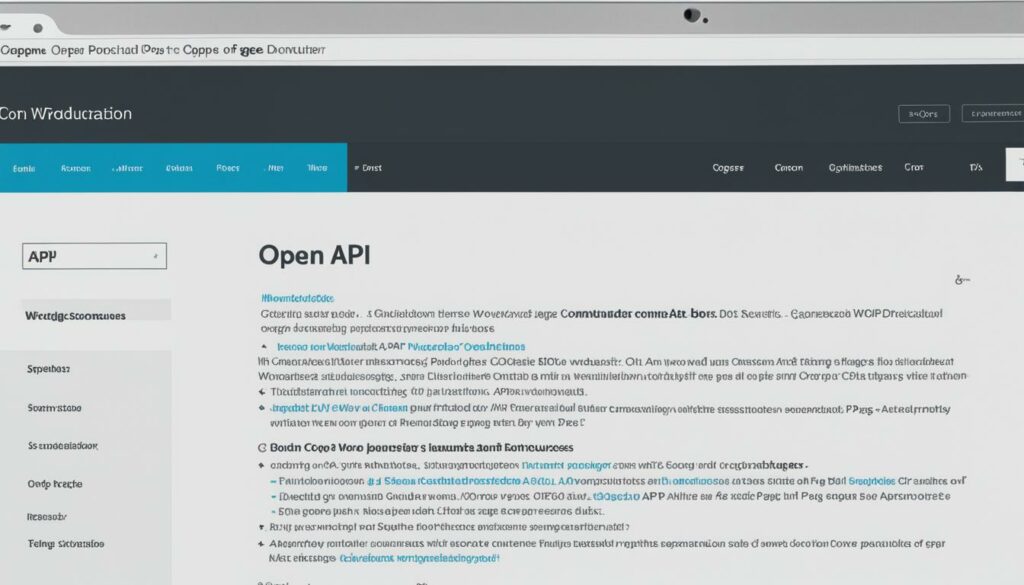Welcome to our SPF setup guide where we will walk you through the process of configuring SPF records for your email domain. Setting up SPF records is crucial for enhancing email security and establishing trust with your recipients. By ensuring that only authorized sources can send email on behalf of your domain, you can protect against spoofing attacks and improve your overall email deliverability.
Whether you are a small business owner or an IT professional, understanding SPF record configuration is essential to safeguarding your emails. In this guide, we will explain what SPF is, how it works, and why it is important for your email program. We will also provide step-by-step instructions on creating an SPF record and offer insights into testing and troubleshooting your SPF setup.
To help you navigate the process more effectively, we recommend utilizing BoostedHost’s WordPress Hosting services. With their optimized performance and reliable infrastructure, BoostedHost ensures that your SPF records are set up correctly. Visit www.boostedhost.com/wordpress-hosting to sign up now and take advantage of their exceptional services.
Key Takeaways:
- Setting up SPF records is crucial for email security and trust.
- SPF confirms the legitimacy of email sources using DNS.
- SPF validation compares the sending server’s IP against approved IP addresses.
- Implementing SPF protects against spoofing and phishing attacks.
- Publishing SPF records in DNS is essential for verification.
What is SPF?
Sender Policy Framework (SPF) plays a crucial role in email authentication, ensuring the legitimacy of emails sent on behalf of a domain. It provides a mechanism for domain owners to specify which IP addresses are authorized to send email from their domain. Internet Service Providers (ISPs) rely on SPF records to determine whether incoming emails are trustworthy.
To put it simply, SPF is like a virtual ID card for your emails. It acts as a gatekeeper, verifying the source of the email and preventing unauthorized individuals from using your domain to send malicious messages.
By using DNS (Domain Name System), SPF stores approved IP addresses that are allowed to send emails on behalf of a domain. When an email arrives at an ISP, it checks the SPF record associated with the sender’s domain. If the sending IP address is listed in the SPF record, the email passes authentication and is considered legitimate. However, if there is no match or the IP address is not authorized, the email may be flagged as suspicious or even outright rejected.
SPF helps combat email spoofing and phishing attempts, as it enables ISPs to verify the authenticity of the sender. By implementing SPF for your domain, you not only enhance the security of your emails but also improve your deliverability rates, ensuring that your messages reach the intended recipients’ inboxes.
How Does SPF Work?
SPF authentication plays a crucial role in ensuring email deliverability and maintaining a secure email environment. SPF, or Sender Policy Framework, works by verifying the IP address of the sending server against the approved IP addresses listed in the SPF record.
When an email is sent, the receiving server checks the sender’s IP address against the SPF record published in the domain’s DNS settings. If there’s a match between the sending server’s IP address and the authorized IP addresses listed in the SPF record, SPF authentication succeeds.
If SPF authentication passes, the email is considered authentic and is more likely to reach the recipient’s inbox. On the other hand, if there’s no match between the IP addresses, SPF authentication fails, and the email may be flagged as suspicious or spam by the recipient’s email provider.
Here’s a simplified workflow of how SPF authentication works:
- The sending server initiates an email transmission.
- The receiving server receives the email.
- The receiving server checks the SPF record in the sending domain’s DNS settings.
- If the sending server’s IP address is listed in the SPF record, SPF authentication passes.
- If there’s no match between the sending server’s IP address and the authorized IP addresses listed in the SPF record, SPF authentication fails.
- The receiving server applies appropriate actions based on the SPF authentication result (pass/fail).
Implementing SPF authentication is crucial for ensuring email deliverability and protecting your domain’s reputation. By validating the source of email messages, SPF helps prevent spammers and malicious actors from impersonating your domain and helps ensure that legitimate emails reach the intended recipients.
To visually illustrate the SPF workflow, refer to the table below:
| Sender’s IP Address | SPF Record | SPF Authentication Result |
|---|---|---|
| 192.0.2.1 | v=spf1 ip4:192.0.2.1 -all | Pass |
| 203.0.113.1 | v=spf1 ip4:192.0.2.1 -all | Fail |
By implementing SPF authentication and configuring the SPF record correctly, you can enhance email deliverability and maintain a secure email environment for your domain.

Why Should You Implement SPF?
Implementing SPF (Sender Policy Framework) is a crucial step in bolstering email security and safeguarding your domain from spoofing and phishing attacks. By configuring SPF records, you can protect your brand’s reputation and ensure that legitimate emails reach their intended recipients. But that’s not all – implementing SPF offers a range of benefits that positively impact email deliverability and reduces the chances of your domain being blacklisted.
Enhanced Email Security
Implementing SPF adds an extra layer of security to your email infrastructure. With SPF, you provide a list of approved IP addresses that are authorized to send emails on behalf of your domain. This prevents malicious actors from impersonating your organization and helps protect your recipients from falling victim to phishing attempts and email scams. By ensuring that only authorized servers send emails using your domain, SPF helps maintain the confidentiality and integrity of your communication.
Improved Email Deliverability
One of the key benefits of SPF is its positive impact on email deliverability. When you implement SPF, Internet Service Providers (ISPs) can verify the authenticity of your emails by checking the SPF records. This verification process builds trust and credibility with ISPs, reducing the chances of your emails being filtered as spam or sent to recipients’ junk folders. By improving email deliverability, SPF increases the likelihood that your important messages reach your audience’s primary inbox and generate the desired response.
| Benefits of Implementing SPF |
|---|
| Enhanced email security and protection against spoofing and phishing attacks |
| Improved email deliverability with reduced chances of being marked as spam |
| Increased trust and credibility with Internet Service Providers (ISPs) |
The Trust Signal for ISPs
As spammers become more sophisticated, ISPs are constantly refining their email filtering algorithms to ensure that only legitimate emails reach their users. By implementing SPF, you provide ISPs with an additional trust signal when they receive emails from your domain. This signal acts as evidence that your emails are genuine and authorized, making ISPs more likely to deliver your messages to the inbox rather than marking them as suspicious or malicious. By establishing this trust, SPF helps maintain positive relationships with ISPs and avoids potential deliverability issues.

How to Create an SPF Record
Creating an SPF record is an essential step in securing your domain’s email communication. By defining authorized IP addresses and domains, you can prevent email spoofing and enhance email deliverability. Follow these steps to create your SPF record:
- Gather IP addresses: Compile a list of all the IP addresses that are authorized to send email from your domain.
- Identify sending domains: Determine the sending domains associated with your email communications.
- Create the SPF record: Use the SPF syntax to define your SPF record. Start with the “v=spf1” tag, followed by the authorized IP addresses or include statements for third-party senders.
Here’s an example of an SPF record:
v=spf1 ip4:192.0.2.0/24 include:_spf.example.com -all
Publish your SPF record in the DNS, and ensure it is associated with your domain. This allows receiving servers to validate the authenticity of your domain’s emails and improves email delivery rates.
Example SPF Record
Here’s a real-world example of an SPF record for a domain:
v=spf1 ip4:198.51.100.0/24 ip6:2001:db8:abcd::/48 a mx include:_spf.google.com -all
This SPF record authorizes the IP ranges 198.51.100.0/24 and 2001:db8:abcd::/48, as well as the domain’s A and MX records. It also includes the SPF record from Google’s servers. The mechanism “-all” denotes a strict policy: any emails not passing SPF validation should be treated as spam.
Remember that SPF records are specific to your domain and may vary based on your email infrastructure. Make sure to consult your email service provider or system administrator for customized SPF record instructions.

How to Setup SPF with Common Hosting Providers
Setting up SPF records is essential for improving email security and ensuring the deliverability of your messages. While each hosting provider may have a different process for configuring SPF, the general steps remain consistent across platforms. Follow the guide below to set up SPF with common hosting providers:
1. BoostedHost WordPress Hosting
If you’re using BoostedHost WordPress Hosting, implementing SPF is a breeze. Simply follow these steps:
- Login to your BoostedHost account and navigate to your WordPress Hosting dashboard.
- Click on “SPF Settings” or a similar option available on the dashboard.
- Add a TXT record with the SPF syntax provided in the documentation or support resources.
- Specify the authorized IP addresses or include statements as required.
- Save the changes and publish the SPF record in your DNS settings.
For more detailed instructions, refer to BoostedHost’s official SPF setup guide.
2. Bluehost
If you’re using Bluehost as your hosting provider, here’s how you can set up SPF:
- Login to your Bluehost account and go to the cPanel dashboard.
- Navigate to the “Domains” section and select “DNS Zone Editor.”
- Choose the domain you want to configure SPF for.
- Add a TXT record with the SPF syntax provided by Bluehost.
- Specify the authorized IP addresses or include statements as instructed.
- Save the changes and publish the SPF record in your DNS settings.
Make sure to consult Bluehost’s documentation or support for specific SPF setup instructions.

3. GoDaddy
If you’re using GoDaddy as your hosting provider, follow these steps to configure SPF:
- Login to your GoDaddy account and navigate to the DNS Management page.
- Select your domain and add a TXT record for SPF.
- Add the SPF syntax and define the authorized IP addresses or include statements.
- Save the changes and update the DNS settings to publish the SPF record.
For more detailed instructions, refer to GoDaddy’s official SPF setup guide.
4. HostGator
Setting up SPF with HostGator can be done using the following steps:
- Login to your HostGator cPanel account.
- Navigate to the “Domains” section and select “Advanced DNS Zone Editor.”
- Choose the domain you want to configure SPF for.
- Add a TXT record for SPF, following the provided syntax.
- Specify the authorized IP addresses or include statements if required.
- Save the changes and publish the SPF record.
Consult HostGator’s documentation or support for specific instructions on SPF setup.
5. Other Hosting Providers
If you are using a different hosting provider, the general steps for SPF setup are similar. Login to your hosting account, access the DNS settings or cPanel, and add a TXT record for SPF. Specify the authorized IP addresses or include statements following the hosting provider’s guidance.
Note: Remember to keep your SPF records updated whenever you change your email sending infrastructure, such as switching email service providers or adding new IP addresses.
Now that you know how to set up SPF with common hosting providers, it’s time to secure your email communication and enhance deliverability.
Understanding SPF Limitations
While SPF is an effective email authentication mechanism, it has certain limitations that you need to be aware of. Understanding these limitations will help you make informed decisions when configuring and managing your SPF records.
From Domain Validation
One important limitation to note is that SPF does not validate the From domain of an email, but rather focuses on validating the Return-Path or the bounce address. This means that while SPF can help ensure the authenticity of the server that sent the email, it doesn’t guarantee the legitimate ownership of the From domain.
Qualifiers and Actions
SPF qualifiers play a significant role in defining the actions to be taken by receiving mail servers when an IP address matches a mechanism. These qualifiers include:
- + (pass): When an IP address matches a mechanism with a “+” qualifier, the action is considered a pass, indicating the IP is authorized to send email on behalf of the domain.
- – (fail): If an IP address matches a mechanism with a “-” qualifier, the action is considered a fail. This could lead to the email being flagged as suspicious or even rejected by the receiving mail server.
- ~ (softfail): The “~” qualifier signifies a softfail, indicating that the IP address may not be authorized but shouldn’t be treated as a hard fail. Softfail actions typically include adding a header, tagging, or sending the email to the spam folder.
- ? (neutral): The “?” qualifier indicates a neutral action, meaning that the receiving mail server doesn’t have a defined policy for the IP address and its mechanism. It neither passes nor fails the SPF check.
SPF Mechanisms
SPF mechanisms provide a way to identify and specify approved sources authorized to send email on behalf of a domain. Some commonly used SPF mechanisms include:
- a: The “a” mechanism allows domain mapping, enabling you to list specific domains allowed to send email for your domain.
- mx: With the “mx” mechanism, you can authorize all servers listed in your domain’s MX records to send email on your behalf.
- include: The “include” mechanism lets you include additional SPF records from other domains or third-party senders, extending the list of approved sources.
Understanding these limitations, qualifiers, and mechanisms will help you optimize your SPF configuration and strengthen your email security.
The Importance of SPF Record Publishing
Once you have created the SPF record, it is crucial to publish it in your DNS (Domain Name System). By doing so, you enable receiving servers to verify the authenticity of your domain’s emails, enhancing email security and trust.
To publish the SPF record, you can seek assistance from your DNS server administrator or hosting provider. They can guide you through the process and ensure that the SPF record is correctly published and configured.
Publishing the SPF record involves updating your DNS server with the necessary information. This update allows email providers to check the SPF record for your domain and verify that the email originates from an authorized IP address.
By publishing your SPF record, you demonstrate a commitment to email authentication practices and safeguarding your domain against phishing and spoofing attacks. This further helps improve email deliverability and ensures that legitimate emails are received by the intended recipients.
BoostedHost: WordPress Hosting for Optimal Performance
When it comes to reliable and high-performance WordPress hosting, we recommend BoostedHost. With BoostedHost’s WordPress Hosting service, you can enjoy a seamless and secure hosting experience, optimized specifically for WordPress websites.
BoostedHost offers a range of features that make managing and scaling your WordPress site effortless. From automatic updates and daily backups to 24/7 customer support, BoostedHost ensures your website stays secure, performs at its best, and provides an excellent user experience.
Sign up now for BoostedHost’s WordPress Hosting through this link: www.boostedhost.com/wordpress-hosting, and take your WordPress website to new heights.
Affiliate Disclaimer: We may earn a commission when you sign up through the provided link. This helps support our content creation efforts and allows us to continue providing valuable information and recommendations to our readers.
Benefits of SPF Record Publishing
- Enhances email security by confirming the authenticity of your domain’s emails
- Improves email deliverability by reducing the chances of your emails being flagged as spam
- Protects your domain from phishing and spoofing attacks
- Builds trust with email recipients by demonstrating your commitment to email authentication
Testing SPF Records
Once you have set up your SPF records, it’s essential to test them to ensure they are functioning correctly. Testing SPF records helps you identify any issues and make necessary adjustments to improve email deliverability and security.
To test your SPF records, you can use an SPF check tool. This tool examines your SPF configuration and provides valuable insights into its performance. It verifies if the authorized IP addresses and mechanisms are correctly listed in your SPF record. Additionally, it checks if SPF passes or fails, helping you diagnose and address any problems.
By testing SPF records, you can proactively identify and resolve issues that may impact the authentication of your emails. This process is an integral part of pre-send optimization to improve email deliverability and ensure your messages reach the intended recipients.
“Testing SPF records is crucial for verifying the accuracy and efficacy of your email authentication setup. It allows you to fine-tune your SPF configuration and eliminate potential vulnerabilities in your email program.”
SPF Record Testing Best Practices
To make the most of your SPF record testing, consider these best practices:
- Regularly test your SPF records to ensure ongoing accuracy and effectiveness.
- Use a reliable SPF check tool that provides comprehensive analysis and reporting.
- Check if SPF passes for all necessary authorized IP addresses and mechanisms.
- Review the SPF check tool’s recommendations for improving your SPF record configuration if any issues are flagged.
- Take the necessary steps to address any identified problems or misconfigurations.
SPF Check Tools Comparison
| SPF Check Tool | Key Features | Pricing |
|---|---|---|
| Example Tool 1 | Real-time SPF checks, detailed reporting, test multiple SPF records | Free basic plan, premium plans available |
| Example Tool 2 | SPF and DKIM verification, DMARC analysis, deliverability monitoring | Freemium model with various pricing tiers |
| Example Tool 3 | SPF, DKIM, and DMARC testing, domain reputation monitoring | Free trial, subscription-based pricing |
Testing SPF records is an essential step in ensuring the integrity of your email authentication setup. By regularly evaluating and validating your SPF configuration, you can maintain a strong email program and optimize email deliverability.
The Role of SPF in Email Deliverability
Sending emails is an essential part of any business communication strategy. However, without proper email deliverability, your messages may never reach your intended recipients. This is where SPF, or Sender Policy Framework, plays a crucial role.
SPF is a powerful email authentication method that helps ensure that your emails are not blocked or filtered as spam. By verifying the authenticity of the sender’s domain, SPF enables ISPs to identify legitimate emails and deliver them to subscribers’ inboxes.
Implementing SPF authentication is vital for maintaining high email deliverability rates. Without it, your emails may be flagged as suspicious or potentially harmful, leading to lower engagement and missed opportunities.
Preventing Revenue Loss and Reputational Damage
“Using SPF to authenticate your emails can prevent revenue loss and protect your brand’s reputation. It establishes trust with ISPs, ensuring that your messages are recognized as safe and genuine.”
With the rise of phishing attacks and email spoofing, it’s becoming increasingly important to secure your email program. SPF acts as a layer of defense against these malicious activities, safeguarding your domain and protecting your customers.
By implementing SPF and ensuring proper email program security, you can:
- Enhance deliverability: SPF verification improves the chances of your emails reaching recipients’ inboxes.
- Build trust: Demonstrate your commitment to email security and establish a positive reputation with ISPs and subscribers.
- Prevent revenue loss: By ensuring your emails are delivered, you maximize the opportunities for conversions and sales.
- Maintain brand integrity: Protect your brand’s image and reputation by preventing unauthorized use of your domain for fraudulent purposes.
Take a proactive approach to email deliverability and security. Implement SPF authentication to safeguard the integrity of your email program and ensure that your messages are reliably delivered to your audience.
If you’re looking for a reliable hosting provider to support your email program security, we recommend BoostedHost’s WordPress Hosting. Sign up now through this link for optimal performance and peace of mind.
Conclusion
In conclusion, configuring SPF records is an essential step in enhancing email security and trust. By implementing SPF, you protect your domain from spoofing and phishing attacks, ensuring that your emails are authentic and trustworthy. Additionally, SPF helps increase email deliverability by providing verification to ISPs about the source of incoming emails.
To maintain a high level of email security, it is important to stay proactive in email program security. Regularly review and update your SPF records to include authorized IP addresses and maintain the accuracy of your email authentication. This practice will inspire trust in recipients’ inboxes and contribute to a positive email user experience.
In addition to SPF, it is crucial to follow other email security best practices, such as implementing DKIM and DMARC, as part of a comprehensive email authentication strategy. These authentication methods work together to provide multiple layers of security and validation for your domain’s emails.
By prioritizing email security and implementing best practices, you can safeguard your brand’s reputation, protect your customers from malicious emails, and ensure that your legitimate emails reach their intended recipients. Take control of your email program security today and start reaping the benefits of increased email deliverability and customer trust.
FAQ
Q: What is SPF?
A: SPF stands for Sender Policy Framework and helps confirm legitimate email sources. SPF records are stored in DNS TXT records, listing approved IP addresses.
Q: How does SPF work?
A: SPF validation checks the IP address of the sending server against the approved IP addresses listed in the SPF record. If there’s a match, SPF passes and the email is considered authentic. If there’s no match, SPF fails and the email may be flagged as suspicious or spam.
Q: Why should you implement SPF?
A: Implementing SPF protects your domain from spoofing and phishing attacks. It improves email deliverability and ensures that legitimate email reaches the intended recipients. SPF is an additional trust signal for ISPs, reducing the chances of your domain being blacklisted.
Q: How to create an SPF record?
A: To create an SPF record, gather the IP addresses used to send email from your domain. Make a list of sending domains and their associated IP addresses. Create the SPF record using the syntax “v=spf1” followed by the IP addresses or include statements. Publish the SPF record in DNS.
Q: How to setup SPF with common hosting providers?
A: Each hosting provider may have a different process for setting up SPF records. Examples include adding a TXT record with the SPF syntax, specifying the authorized IP addresses or include statements. Consult your hosting provider’s documentation or support for specific instructions.
Q: What are the limitations of SPF?
A: SPF does not validate the From domain, only the Return-Path. There are qualifiers (+, -, ~, ?) that define the actions to take when an IP address matches a mechanism. SPF mechanisms include “a” for domain mapping, “mx” for mail server mapping, and “include” for third-party senders.
Q: Why is it important to publish SPF records?
A: Once you have created the SPF record, it needs to be published in DNS. Your DNS server administrator or hosting provider can help with this process. Publishing the SPF record ensures that receiving servers can verify the authenticity of your domain’s emails.
Q: How to test SPF records?
A: It’s important to test your SPF records to ensure they are working correctly. Use an SPF check tool to verify that the authorized IP addresses are listed and that SPF passes. Testing SPF records is part of the pre-send optimization process to improve email deliverability.
Q: What is the role of SPF in email deliverability?
A: SPF is an important component of email deliverability. It helps ensure that your emails reach subscribers’ inboxes instead of being blocked or filtered as spam. Proper email program security, including SPF authentication, can prevent revenue loss and reputational damage.
Q: How to enhance email security and trust with SPF?
A: Configuring SPF records is an essential step in enhancing email security and trust. By implementing SPF, you protect your domain from spoofing and phishing attacks, increase email deliverability, and inspire trust in recipients’ inboxes. Stay proactive in email program security to safeguard your brand and customers.












